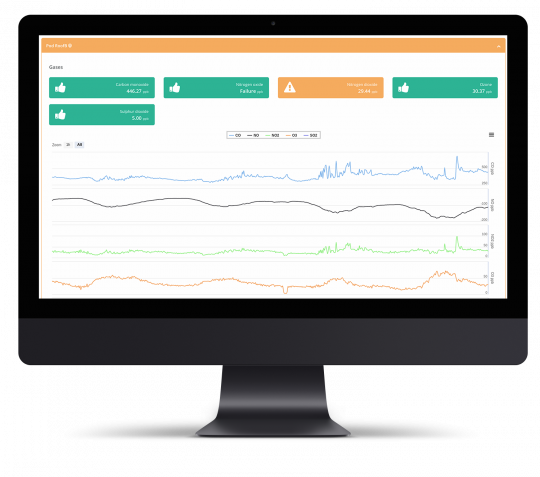Indoor Air Quality
THE IMPORTANCE OF INDOOR AIR QUALITY
Indoor air quality is a key factor in the health and well-being of building occupants. Traditionally low levels of indoor CO2 have been used as a surrogate to represent good indoor air. However, the reality is significantly more complex as buildings trap, generate and accumulate pollutants.
Significantly the outdoor air can no longer be considered fresh. Our peer-reviewed research shows that low indoor CO2 in urban settings is often achieved at the expense of higher levels of more harmful pollutants such as nitrogen dioxide (NO2) and particulate matter (PM).
Indeed, since pollution is not a scheduled event, without intelligent control most urban buildings can accumulate pollutants to levels that are worse than those found outside.
 WHAT OUR SENSOR MEASURES
WHAT OUR SENSOR MEASURES
Our multi-gas and PM sensor measures the following gasses and particulates: NO2, nitrogen oxide (NO), sulphur dioxide (SO2), ozone (O3), PM1 (particulate matter of 1 micron or smaller), PM2.5 and PM10, temperature, humidity and pressure.
![]() POLLUTANTS & REACTIONS
POLLUTANTS & REACTIONS
Maintaining optimal air quality requires such detailed measurements because pollutants react chemically within buildings. For example, NO reacts with O3 to yield the significantly more harmful NO2. Using this data, Future Decisions patent-pending hardware & software provides significantly improved air quality. This is achieved by monitoring and controlling the levels of both direct pollutants and their chemical precursors. PROVEN RESULTS
PROVEN RESULTS
In a recent deployment, for example, our solution reduced internal levels of NO, NO2, SO2, O3, PM10, PM2.5, PM1, CO and CO2 by up to 30%, in addition to reducing the power demand from air handling systems by 53%.

LEGAL COMPLIANCE
Every building in London is almost certainly breaking UK/EU law on Air Quality. Buildings are bringing in polluted external air whilst also generating their own pollutants aggravating the problem, particularly as they can trap and hold the poor quality air. This tends to result in the indoor air being of worse quality than that found outside.
Poor air quality impacts on worker productivity (sick building syndrome) but more importantly increase significantly the likelihood of serious diseases including stroke, cancer, asthma, heart disease, obesity, diabetes and dementia. In addition, it has a significant link to premature death with 44,000 premature deaths per year in the UK and 400,000 across Europe.
Building owners and are required to do what is reasonable to protect their occupants.
WHAT YOU CAN DO
We usually suggest a month up to three of monitoring using our multi-gas and particulate matter sensors pods.
This allows us to measure the extent of the problem and device which strategy is best suited to counter it.
The first strategy is to implement our Indoor Air Quality control algorithms where permanent sensors are installed that integrate with our Digital Building Platform and enable algorithmic control of your HVAC systems.
This is usually enough to drop internal pollution levels by up to 30%. In acute cases, it may be necessary to combine the algorithmic approach with a chemical scrubber to ensure compliance.
 OUR SOLUTION
OUR SOLUTION
Our patented solution combines machine learning and state estimation techniques, to derive bespoke optimal operating parameters for any individual building. These parameters are updated in real-time as necessary and supplied as control signals to the building’s heating, ventilation and air conditioning (HVAC) systems.
As a result, our solution typically reduces indoor air pollutants to levels that are within EU/UK regulation.
We often meet the stricter WHO guidelines.
 LIABILITY
LIABILITY
Future Decisions has been working with both insurance and legal professionals to determine where liability lies for air quality in the working environment.
Our current understanding is that there is no difference in regulatory requirements between internal and external air, however, liability differs in each case.
The employer, building owner or building manager is responsible for internal air quality although, to the best of our knowledge, this point is as yet untested in a court of law.
Book a Demo
Join us on a live tour of our products and get the answers you need


